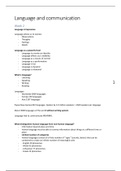Language and communication
Week 2
Language is Expressive
Language allows us to express
- Observations
- Thoughts
- Feelings
- Needs
Language as a powerful tool
- Language to create our identity
- Language affects our credibility
- Language as a means of control
- Language as a performative
- Language is fun
- Language is dynamic
- Language is relational
What is language?
- Listening
- Speaking
- Writing 1
- Reading
Languages
- Wordwide 6909 languages
- Europe 230 languages
- Asia 2197 languages
Papua New Guinea 832 languages. Spoken by 3.9 million speakers = 4500 speaker per language
About 3000 languages of the world without writing system.
Language had to communicate MEANING.
What distinguishes human language from non-human language?
- Information beyond place and time
- Human language must be able to convey information about things at a different time or
place
- Limited number of categories
- Human languages consist of a finite number of ‘’signs’’ (sounds, letters) that can be
combined to create an infinite number of meaningful units
- - English 49 phonemes
- - Welsh 62 phonemes
- - Lithuanian 77 phonemes
- - Greek 23 phonemes
, ➔ Double articulation
We have different sounds in a language, but our sounds can combine. So the sounds have
two functions
Discreteness
- Every language has its own set of discrete units (phonemes, morphemes, words, phrases
etc.)
- What is discrete in one language, does not have to be in another
Productivity
1. I thought, that you thought, that he thought, that she thought…
2. A brilliant, colourful, original, skifylly designed, beautifully framed… picture
- Language is infinitely productive
- New words
Arbitrariness
- No relation between sound and meaning of a word
- Sound inventory of a language is arbitrary
- Patterns in which sounds and words combine are arbitrary
Modularity
- Language is a modular system
- Language production and perception draw on different modules
- Every module is responsible for part of the language production/ perception process
- Modules are related and interdependent
- Modules: phonetics/phonology, morphology, syntax, lexicon/semantics, pragmatics,
discourse organization
2
Further characteristics of human language
Context dependence
1. Bank = the land alongside or sloping down to a river vs.
bank = organization that provides financial services vs.
bank = to travel with one side higher than the other
2. Their vs. there vs. they’re
3. Rights vs. write
Constituency and recursion
1. She gives a lecture
2. The woman with the dark glasses gives a lecture
3. The short haired woman with the dark glasses and the necklace gives a lecture
, - Constituency allows for flexibility and structure
- Constituency allows for recursiveness
Variability
- Some universal characteristics
- Differences between individual languages
- Differences between speakers of the same language
- Language use of individual speakers differs depending on situation and people they speak to
- Language is used to establish social identity
- Standard vs. nonstandard varieties
Communication: the process of using symbols to exchange meaning
Non-human (primate) communication
- Gestures used by apes are largely innate (more recent research shows that they can be
learned over time)
- Gestures are used intentionally
- Intentional gestures are used to request/deman actions form others (getting attenditon –
demanding action)
- Apes use communication for their own goals, there are no jointly shared goals
- Understanding and production of gestures is based on an understanding that others have
goals and ‘’expectations’’ about what others are going to do (in a very practical sense in a
particular situation)
Human communication
- Human communication is more complex because social-cognitive infrastructure not only 3
covers cskills for understanding individual intentionality, but skills for shared intentionality
- Ability to mind read and ‘’collect’’ mental representations (experience) allows for the
generation of joint attention and joint goals
- Motives for shared intentionality: requesting, informing, sharing emotions and attitudes
- Underlying principle: cooperation and intentionality, joint goal = successful communication
Linear Model of Communication
Criticism linear model of communication
- model suggest that communication is a one way process
- Model fail to show the influence of context
- Model not able to reflect human to human communication
, Interaction Model of Communication
Ciriticism Interaction Model of communication
- Very technical approach
- Communication is more than a process of sending and receiving messages
- We cannot consciously decide to stop communicating
- Role of context beyond physical and psychological context is not represented
Transactional Model of communication
4
Basic function of verbal communication
- Helps to define reality
- Helps to orgnaise complex ideas and experiences (categorization)
- Helps to think
- Helps to shape attitudes about the world





